 À tous mes amis en France – toutes mes pensées sont avec vous. Je l’aime et admire France. Soit brave!
À tous mes amis en France – toutes mes pensées sont avec vous. Je l’aime et admire France. Soit brave!
Chris
author of The Prestige, The Separation and the story collection Episodes
I have been reading a lot of Patricia Highsmith recently, notably her novel This Sweet Sickness. I carried the book with me on a recent journey to France, one that took several hours in both directions and involved much hanging around in airports and train stations. It did what I hoped it would do, and that was distract me from the endless noise and discomforts of travel delays.
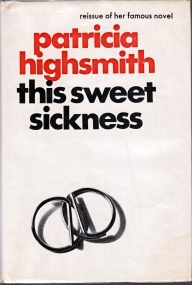 This Sweet Sickness (1960) is about a clever, educated and not unattractive man called David Kelsey. Kelsey has become obsessed with a young woman, Annabelle, whom he hopes and intends to marry. He has constructed a secret alternative identity, which he adopts every weekend. Under a false name, William Neumeister, he goes to stay in a house in the countryside close to where Annabelle lives. Here he lives out a fantasy in which he imagines himself greeting his paramour, showing her proudly around the house, preparing lavish meals for two, opening bottles of fine wines, and so on. Between all this he writes letters to Annabelle, pleading with her to give up her present life and move to be with him (but she has married someone else, and has had a child). Sometimes he telephones her and sometimes he goes to hang around the place where she lives. From time to time Annabelle relents and agrees to meet him, but only to emphasize forcefully that he must back off and leave her alone. Kelsey always wrongly interprets these contacts with her, wilfully blinding himself to reality. Kelsey is, in short, a stalker. A death takes place, partly caused by Kelsey’s actions, and to try to divert police attention from his own role in the incident, Kelsey poses as Neumeister and approaches the police with a false story about an accident. ‘Neumeister’ having diverted suspicion from Kelsey then contrives to disappear into the web of lies that has sustained Kelsey’s fantasy life. For most of the book Kelsey manages to keep Neumeister at a distance from himself, but later there is another semi-deliberate killing.
This Sweet Sickness (1960) is about a clever, educated and not unattractive man called David Kelsey. Kelsey has become obsessed with a young woman, Annabelle, whom he hopes and intends to marry. He has constructed a secret alternative identity, which he adopts every weekend. Under a false name, William Neumeister, he goes to stay in a house in the countryside close to where Annabelle lives. Here he lives out a fantasy in which he imagines himself greeting his paramour, showing her proudly around the house, preparing lavish meals for two, opening bottles of fine wines, and so on. Between all this he writes letters to Annabelle, pleading with her to give up her present life and move to be with him (but she has married someone else, and has had a child). Sometimes he telephones her and sometimes he goes to hang around the place where she lives. From time to time Annabelle relents and agrees to meet him, but only to emphasize forcefully that he must back off and leave her alone. Kelsey always wrongly interprets these contacts with her, wilfully blinding himself to reality. Kelsey is, in short, a stalker. A death takes place, partly caused by Kelsey’s actions, and to try to divert police attention from his own role in the incident, Kelsey poses as Neumeister and approaches the police with a false story about an accident. ‘Neumeister’ having diverted suspicion from Kelsey then contrives to disappear into the web of lies that has sustained Kelsey’s fantasy life. For most of the book Kelsey manages to keep Neumeister at a distance from himself, but later there is another semi-deliberate killing.
It’s an interesting study of the psychology of a stalker, but also a fascinating illustration of the way apparently harmless lies create an inescapable trap, as only new and more complex lies must be devised to evade justice. Kelsey moves slowly to an inevitable (but not entirely predictable) fate.
Highsmith’s novels intriguingly often feature non-murders, or semi-murders, almost as if the author shrinks away from the brutal act.
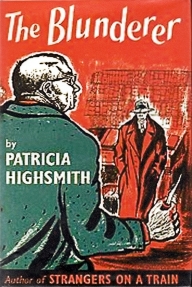 Her third novel, The Blunderer (1954), is typical. Walter Stackhouse is plotting in a blundering sort of way to kill his unstable wife Clara, when she happens to die anyway. Because Walter was closely shadowing her movements at the time, the police treat her death as murder and start to investigate. Meanwhile, Walter becomes obsessed with a similar unsolved crime, in which a bookseller appears to have murdered his own wife. The two men meet. The cop investigating them both is a dangerous psychotic.
Her third novel, The Blunderer (1954), is typical. Walter Stackhouse is plotting in a blundering sort of way to kill his unstable wife Clara, when she happens to die anyway. Because Walter was closely shadowing her movements at the time, the police treat her death as murder and start to investigate. Meanwhile, Walter becomes obsessed with a similar unsolved crime, in which a bookseller appears to have murdered his own wife. The two men meet. The cop investigating them both is a dangerous psychotic.
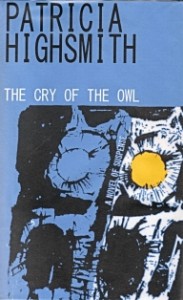 The Cry of the Owl (1963) is about another stalker, or more accurately a Peeping Tom. Robert Forrester is spying on Jenny, fantasizing about her life in the house where she lives. Jenny spots him one night as he lurks in her darkened garden, and unexpectedly befriends him. A weird relationship develops, but her fiancé Greg is unsurprisingly not too pleased. Robert and Greg fight violently, and Robert comes off the better. Greg’s body then disappears, leaving Robert in the familiar Highsmithian dilemma of not knowing for sure if he is a murderer or not.
The Cry of the Owl (1963) is about another stalker, or more accurately a Peeping Tom. Robert Forrester is spying on Jenny, fantasizing about her life in the house where she lives. Jenny spots him one night as he lurks in her darkened garden, and unexpectedly befriends him. A weird relationship develops, but her fiancé Greg is unsurprisingly not too pleased. Robert and Greg fight violently, and Robert comes off the better. Greg’s body then disappears, leaving Robert in the familiar Highsmithian dilemma of not knowing for sure if he is a murderer or not.
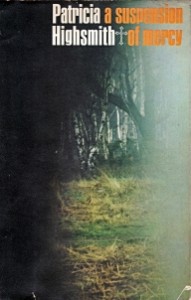 A Suspension of Mercy (1965) is one of my favourites, with a plot not dissimilar to The Blunderer: Bartleby, an American writer living unhappily in Britain with his young wife Alicia, plans to kill her. While Alicia is away visiting a friend, he rehearses how he would actually perform the deadly act, and this includes acting out the murder, then going through the motions of moving her body away from the house and concealing it. Unfortunately, Bartleby’s rehearsal is witnessed by an elderly neighbour (or is it?), and he is incriminated. When Alicia does not return from her visit, and appears to have gone missing, the police start investigating.
A Suspension of Mercy (1965) is one of my favourites, with a plot not dissimilar to The Blunderer: Bartleby, an American writer living unhappily in Britain with his young wife Alicia, plans to kill her. While Alicia is away visiting a friend, he rehearses how he would actually perform the deadly act, and this includes acting out the murder, then going through the motions of moving her body away from the house and concealing it. Unfortunately, Bartleby’s rehearsal is witnessed by an elderly neighbour (or is it?), and he is incriminated. When Alicia does not return from her visit, and appears to have gone missing, the police start investigating.
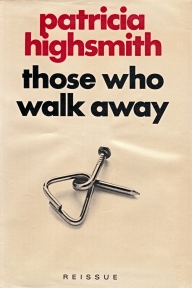 In Those Who Walk Away (1967), a man called Coleman blames his son-in-law Ray for the recent and premature death of his daughter, even though Ray too is of course mourning his loss. Coleman attacks Ray while they are in Rome and leaves him for dead. Ray however recovers and escapes to Venice. Coleman follows him, not certain if Ray actually died or not. Ray seizes an opportunity for revenge and Coleman is apparently killed, but again there is no certain evidence of Coleman’s death. The two men stalk each other through the wintry alleys and along the dark canalsides of Venice, both descending into a web of concealment, deception and sudden violence.
In Those Who Walk Away (1967), a man called Coleman blames his son-in-law Ray for the recent and premature death of his daughter, even though Ray too is of course mourning his loss. Coleman attacks Ray while they are in Rome and leaves him for dead. Ray however recovers and escapes to Venice. Coleman follows him, not certain if Ray actually died or not. Ray seizes an opportunity for revenge and Coleman is apparently killed, but again there is no certain evidence of Coleman’s death. The two men stalk each other through the wintry alleys and along the dark canalsides of Venice, both descending into a web of concealment, deception and sudden violence.
These books are classic page-turners and any of them would make a great film, as some of her books already have. My first awareness of Highsmith’s work was in the early 1960s, when Alfred Hitchcock’s film of Strangers on a Train was briefly re-released into cinemas as ‘classic Hitchcock’. (His film Psycho had been a major success in 1960.) This was a time when I was starting to take note of writers who wrote films, or whose work was adapted. I had never heard of Highsmith – Strangers was her first novel, published in 1950 – and I began looking with interest for her books. In spite of Hitchcock’s film she was not then a well-known or widely distributed writer, and the only book of hers I could find was a paperback tie-in of the film.
Over the following years Highsmith built her reputation steadily through her novels. Most of her books were initially published in hard covers, although in Britain at least the editions were usually cheap-looking, aimed at library buyers. An early adaptation of The Talented Mr Ripley was made in 1960 in France as Plein Soleil (or Purple Noon), directed by René Clément and starring Alain Delon. Other films have followed, including The Cry of the Owl in 1987, a remake of Mr Ripley in 1999, directed by Anthony Minghella and starring Matt Damon, The Two Faces of January in 2014, and Carol in 2015. Highsmith’s books are now much easier to find, both new and second-hand.
Gradually, her work is coming to identify in a loose sense with America in the early 1950s, although through nearly all of her working life she was living in Europe. In Highsmith’s novels most of the characters have regular jobs, they drive cars, buy houses. In those pre-internet days they make phone-calls and write each other letters. They become engaged and sometimes marry, and they do not, usually, have pre-marital sex. They drink a lot but rarely do drugs. Other than Tom Ripley her characters are not career criminals, but are ordinary people with slightly dysfunctional lives, who drift into murder on an impulse, or by mistake, or as a consequence of an earlier, lesser crime.
There’s a good biography called Beautiful Shadow by Andrew Wilson (2003), and she wrote an excellent book about thrillers called Plotting and Writing Suspense Fiction (1966).